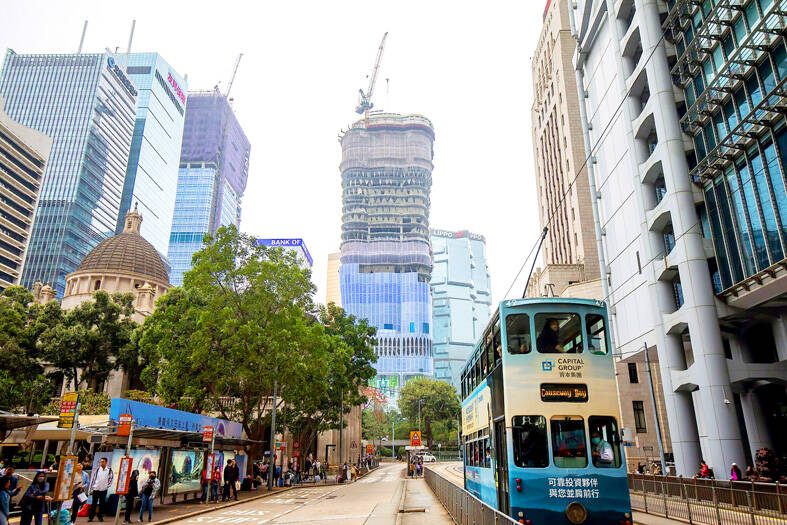Hong Kong’s labor market has seen its sharpest drop on record, underscoring the territory’s challenges with an aging population and outflow of talent.
The territory’s working population last year fell 94,100, down 2.4 percent, according to data released on Monday by the Hong Kong Census and Statistics Department.
It is the largest decline in the territory’s labor force since the government began keeping records in 1985.

Photo: Bloomberg
Hong Kong is running an uphill battle as the government seeks to kick-start an economy that recorded its third annual contraction in four years. Tens of thousands of people, including lawyers and bankers, left the territory following the National Security Law and strict COVID-19 pandemic curbs.
A labor shortage would affect services for the public and the territory’s competitiveness, Hong Kong Chief Executive John Lee (李家超) said at a daily news conference yesterday.
Lee has made attracting talent a key priority for his administration. In October last year, he started a global talent program that includes a two-year visa plan for high-income workers and top university graduates.
So far, the program has mostly attracted interest from Chinese. Most of the about 10,000 applications are from the mainland, according to local media.
The territory is also competing with Singapore to attract wealth business. The Hong Kong government last month announced that it would cut taxes for family offices.
One of Hong Kong’s biggest hurdles is staffing its tourism sector dented by COVID-19 curbs.
The industry, along with exports, could help the economy grow by an estimated 7.6 percent, according to a Goldman Sachs Group Inc forecast.

The US dollar was trading at NT$29.7 at 10am today on the Taipei Foreign Exchange, as the New Taiwan dollar gained NT$1.364 from the previous close last week. The NT dollar continued to rise today, after surging 3.07 percent on Friday. After opening at NT$30.91, the NT dollar gained more than NT$1 in just 15 minutes, briefly passing the NT$30 mark. Before the US Department of the Treasury's semi-annual currency report came out, expectations that the NT dollar would keep rising were already building. The NT dollar on Friday closed at NT$31.064, up by NT$0.953 — a 3.07 percent single-day gain. Today,

‘SHORT TERM’: The local currency would likely remain strong in the near term, driven by anticipated US trade pressure, capital inflows and expectations of a US Fed rate cut The US dollar is expected to fall below NT$30 in the near term, as traders anticipate increased pressure from Washington for Taiwan to allow the New Taiwan dollar to appreciate, Cathay United Bank (國泰世華銀行) chief economist Lin Chi-chao (林啟超) said. Following a sharp drop in the greenback against the NT dollar on Friday, Lin told the Central News Agency that the local currency is likely to remain strong in the short term, driven in part by market psychology surrounding anticipated US policy pressure. On Friday, the US dollar fell NT$0.953, or 3.07 percent, closing at NT$31.064 — its lowest level since Jan.

The New Taiwan dollar and Taiwanese stocks surged on signs that trade tensions between the world’s top two economies might start easing and as US tech earnings boosted the outlook of the nation’s semiconductor exports. The NT dollar strengthened as much as 3.8 percent versus the US dollar to 30.815, the biggest intraday gain since January 2011, closing at NT$31.064. The benchmark TAIEX jumped 2.73 percent to outperform the region’s equity gauges. Outlook for global trade improved after China said it is assessing possible trade talks with the US, providing a boost for the nation’s currency and shares. As the NT dollar

The Financial Supervisory Commission (FSC) yesterday met with some of the nation’s largest insurance companies as a skyrocketing New Taiwan dollar piles pressure on their hundreds of billions of dollars in US bond investments. The commission has asked some life insurance firms, among the biggest Asian holders of US debt, to discuss how the rapidly strengthening NT dollar has impacted their operations, people familiar with the matter said. The meeting took place as the NT dollar jumped as much as 5 percent yesterday, its biggest intraday gain in more than three decades. The local currency surged as exporters rushed to